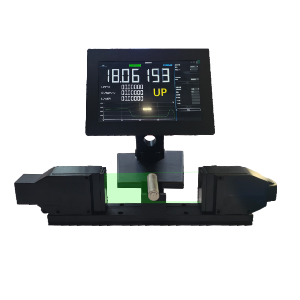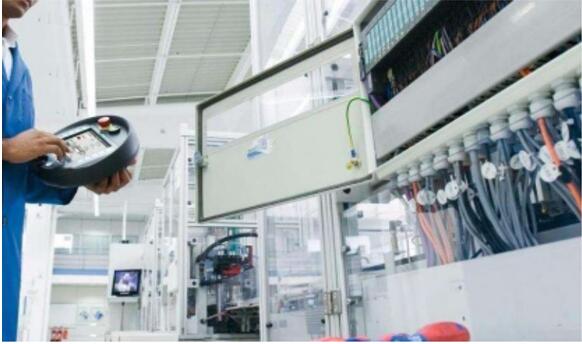What are the key factors affecting the accuracy of a laser caliper?
In the field of precision manufacturing and quality inspection, laser calibrators can be embedded in production lines to quickly measure wire diameters due to their non-contact and high accuracy advantages. But why the same equipment in different working conditions, the measurement results are very different? In fact, from the microscopic quality of the laser beam to the macro-environmental interference, many factors are quietly affecting its measurement accuracy. Next, we will explore these key influencing factors.


I. Hardware System Factors
1. Laser source stability
① wavelength and power fluctuations: the stability of the laser wavelength directly affects the optical system ranging benchmark, if the wavelength drift (such as temperature changes in the semiconductor laser wavelength shift), it will introduce measurement errors; power fluctuations will affect the signal strength at the receiving end, resulting in a decline in the accuracy of edge detection.
② beam quality: laser beam divergence angle, spot shape (such as ellipticity) and focusing accuracy is not enough, will make the scanning spot coverage is not stable, especially in the measurement of small-sized objects, spot edge blurring will lead to diameter calculation deviation.
2. Optical system accuracy
① lens and scanning device: lens distortion (such as barrel distortion), chromatic aberration or focal length deviation will lead to laser beam scanning path deviation; scanning prism or galvanometer speed stability is not enough to make the scanning speed is not uniform, which in turn affects the accuracy of the time - distance conversion.
② optical component contamination: dust, oil or water vapor on the surface of the lens, reflector will weaken the light intensity, resulting in a lower signal-to-noise ratio of the received signal, or even produce false fringe signals.
3. Mechanical structure stability
① mechanical vibration and displacement: insufficient rigidity of the mounting base of the caliper or environmental vibration will lead to changes in the relative position of the laser transmitter and receiver, resulting in scanning trajectory offset; wear and tear of the guide rails or loosening of the moving parts, which will make the scanning mechanism of the straightness or perpendicularity of the deviation.
② temperature deformation: the thermal expansion and contraction of mechanical parts (such as metal brackets) under temperature change will change the geometric parameters of the laser optical path, especially in high-precision measurements (e.g., micron level), every 1 ℃ change in temperature may lead to errors of several microns.
II. Environment and Disturbances
1. Environmental temperature, humidity and airflow
① temperature effects: temperature changes will lead to laser wavelength drift (such as semiconductor laser wavelength with temperature changes of about 0.3-0.5nm / ℃), while affecting the dimensional accuracy of the mechanical components; measurement of the ambient temperature fluctuations over the range of the equipment calibration, the need for thermostat control or temperature compensation algorithm to correct.
② humidity and dust: high humidity environment may lead to cold condensation fog optical components, dust particles will scatter the laser, both will reduce the signal quality, especially in the open measurement scene is more obvious.
2. Electromagnetic interference and vibration
① electromagnetic interference: electromagnetic radiation generated by peripheral high-frequency equipment (such as frequency converters, motors) will interfere with the signal acquisition circuit, resulting in AD conversion error or clock frequency shift, affecting the accuracy of time measurement.
② mechanical vibration: the vibration of the object to be measured or environmental vibration will cause the laser beam to generate a periodic shift in scanning, especially in dynamic measurements (such as high-speed movement of the wire), which will easily lead to “false shadow” error.
III. Characteristics of Objects to be Measured
1. Surface topography and optical properties
① surface roughness: rough surface will make the laser diffuse reflection, resulting in fluctuations in signal strength at the receiving end, edge detection algorithms are difficult to accurately identify the boundary of the spot occlusion; specular reflective surface may produce multi-path reflection, triggering signal distortion.
② transparency and color: transparent objects (such as glass filaments) will make the laser partially penetrate, resulting in occlusion signal weakening; dark-colored objects have a strong absorption of laser light, which may lead to edge detection threshold shift due to insufficient light intensity.
2. Motion and shape
① motion stability: axial runout, eccentricity or oscillation of the measured object (e.g. ellipticity when the wire is rotating) will make the actual measured cross-section deviate from the ideal circle, resulting in fluctuation of the diameter measurement value.
② complexity of cross-section shape: irregular cross-section (e.g., shaped pipe) or the presence of grooves and bumps on the surface, the laser scanning may not be able to cover the complete contour, resulting in the measured value deviating from the true diameter.
IV. System Calibration and Algorithmic Errors
1. Calibration accuracy and frequency
① calibration reference deviation: if the standard used for calibration (e.g. gauge) has insufficient accuracy, or if there is installation error during calibration (e.g. the standard is not perpendicular to the laser beam), it will lead to a shift in the reference value of the system, and there will always be a fixed error in the subsequent measurements.
② long-term drift uncorrected: laser calibrator optical components aging, mechanical parts wear and tear will lead to degradation of accuracy, if not calibrated regularly (such as quarterly or half a year), the error will gradually accumulate.
2. Signal processing and algorithm defects
① sampling and filtering algorithms: insufficient data sampling frequency (e.g., less than 2 times the frequency of the measured object movement) will lead to signal distortion; filtering algorithms with improper parameter settings (e.g., bandwidth is too wide) may filter out the real edge of the signal or retain the noise.
② edge detection algorithms: unreasonable threshold setting, spot edge fitting algorithms (such as Gaussian fitting, threshold segmentation) is not accurate enough, will make the calculated diameter value deviate from the actual value, especially in the low signal-to-noise ratio scenarios, the error is more significant.
V. Installation and Operation Factors
1. Installation of coaxiality and perpendicularity: the transmitting and receiving ends of the laser calibrator are not strictly perpendicular to the direction of movement of the object to be measured, which will lead to an elliptical rather than circular scanning trajectory, and the measured value will be large or small; the center of the object to be measured is not aligned with the center of the laser beam, which will lead to the introduction of eccentricity error.
2. Operation standardization of laser calibrator accuracy is the result of hardware performance, environmental control, the characteristics of the measured object and system calibration. In practice, it is necessary to optimize the hardware configuration for specific scenarios (e.g., choosing a constant temperature laser source, high-resolution optical system), controlling environmental interference, and compensating for this through high-precision calibration and adaptive algorithms in order to achieve micron or even nanometer-level measurement accuracy.
Product recommendation
TECHNICAL SOLUTION
MORE+You may also be interested in the following information
FREE CONSULTING SERVICE
Let’s help you to find the right solution for your project!


 ASK POMEAS
ASK POMEAS  PRICE INQUIRY
PRICE INQUIRY  REQUEST DEMO/TEST
REQUEST DEMO/TEST  FREE TRIAL UNIT
FREE TRIAL UNIT  ACCURATE SELECTION
ACCURATE SELECTION  ADDRESS
ADDRESS Tel:+ 86-0769-2266 0867
Tel:+ 86-0769-2266 0867 Fax:+ 86-0769-2266 0867
Fax:+ 86-0769-2266 0867 E-mail:marketing@pomeas.com
E-mail:marketing@pomeas.com
